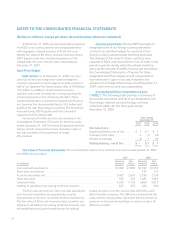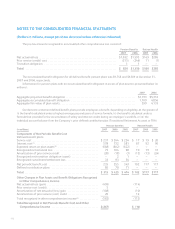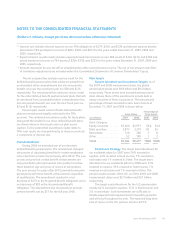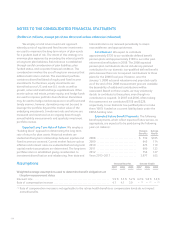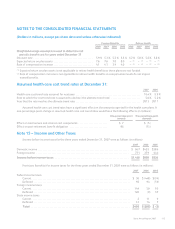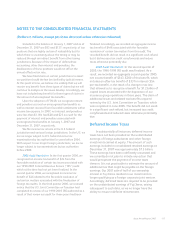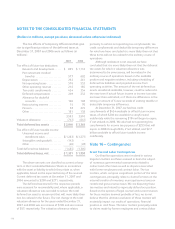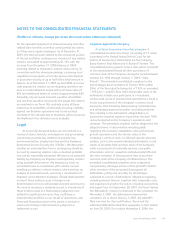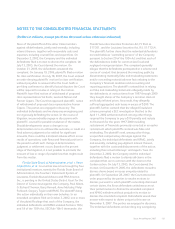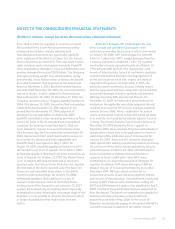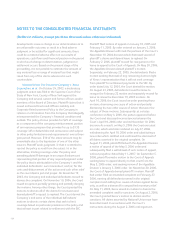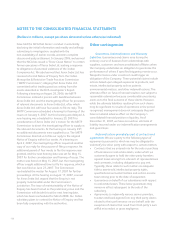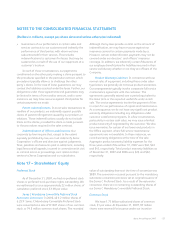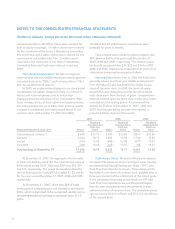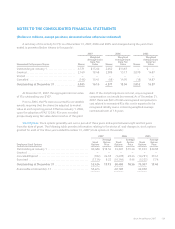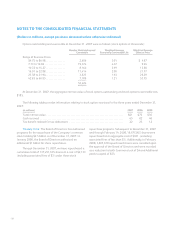Xerox 2007 Annual Report Download - page 122
Download and view the complete annual report
Please find page 122 of the 2007 Xerox annual report below. You can navigate through the pages in the report by either clicking on the pages listed below, or by using the keyword search tool below to find specific information within the annual report.NOTES TO THE CONSOLIDATED FINANCIAL STATEMENTS
(Dollars in millions, except per-share data and unless otherwise indicated)
International Brotherhood of Electrical Workers Welfare
Fund of Local Union No. 164 (“IBEW”) filed a motion to
intervene as a named plaintiff and class representative.
Separately, on June 8, 2005, IBEW and Robert W. Roten
(“Roten”) moved to substitute as lead plaintiffs and
proposed class representatives. On May 12, 2006, the
Court denied, without prejudice to refiling, plaintiffs’
motion for class certification, IBEW’s motion to intervene
and serve as named plaintiff and class representative, and
IBEW and Roten’s joint motion to substitute as lead
plaintiffs and proposed class representatives. The Court
also ordered the parties to submit to it a notice to certain
putative class members to inform them of the
circumstances surrounding the withdrawal of several lead
plaintiffs, and to advise them of the opportunity to
express their desire to serve as a representative of the
putative class. On July 25, 2006, the Court so-ordered a
form of notice, and plaintiffs thereafter distributed the
notice. Thereafter, Roten, Robert Agius (“Agius”) and
Georgia Stanley (“Stanley”) filed applications to be
considered lead plaintiffs. On November 13, 2006, IBEW,
Roten, Agius and Stanley filed a motion for appointment
as additional lead plaintiffs. Defendants filed their
response on November 28, 2006. On February 2, 2007, the
Court granted the motion of IBEW, Roten, Agius and
Stanley and appointed them as additional lead plaintiffs.
On February 15, 2007, lead plaintiffs IBEW, Roten, Agius,
Stanley and Thomas Dalberth filed their renewed motion
for class certification. On July 18, 2007, the Court entered
an order denying plaintiffs’ renewed motion for class
certification, without prejudice to renewal after the Court
holds a pre-filing conference to identify factual disputes
the Court will be required to resolve in ruling on the
motion. On December 12, 2007, the Court held a pre-filing
conference and granted, absent objection, the motion of
Agius to withdraw as lead plaintiff and proposed class
representative. On February 5, 2008 plaintiffs filed a
second renewed motion for class certification. The parties
are currently engaged in discovery. The individual
defendants and we deny any wrongdoing and are
vigorously defending the action. In the course of
litigation, we periodically engage in discussions with
plaintiffs’ counsel for possible resolution of the matter.
Should developments cause a change in our
determination as to an unfavorable outcome, or result in a
final adverse judgment or be settled for significant
amounts, there could be a material adverse effect on our
results of operations, cash flows and financial position in
the period in which such change in determination,
judgment or settlement occurs. Based on the present
stage of the litigation, it is not possible to estimate the
amount of loss or range of possible loss that might result
from this matter.
Carlson v. Xerox Corporation, et al.: A consolidated
securities law action (consisting of 21 cases) is pending in
the United States District Court for the District of
Connecticut against the Company, KPMG and Paul A.
Allaire, G. Richard Thoman, Anne M. Mulcahy, Barry D.
Romeril, Gregory Tayler and Philip Fishbach. On
September 11, 2002, the Court entered an endorsement
order granting plaintiffs’ motion to file a third
consolidated amended complaint. According to the third
consolidated amended complaint, plaintiffs purport to
bring this case as a class action on behalf of a class
consisting of all persons and/or entities who purchased
Xerox common stock and/or bonds during the period
between February 17, 1998 through June 28, 2002 and
who were purportedly damaged thereby (“Class”). The
third consolidated amended complaint sets forth two
claims: one alleging that each of the Company, KPMG,
and the individual defendants violated Section 10(b) of
the 1934 Act and SEC Rule 10b-5 thereunder; and the
other alleging that the individual defendants are also
liable as “controlling persons” of the Company pursuant to
Section 20(a) of the 1934 Act. Plaintiffs claim that the
defendants participated in a fraudulent scheme that
operated as a fraud and deceit on purchasers of the
Company’s common stock and bonds by disseminating
materially false and misleading statements and/or
concealing material adverse facts relating to various of
the Company’s accounting and reporting practices and
financial condition. The plaintiffs further allege that this
scheme deceived the investing public regarding the true
state of the Company’s financial condition and caused
the plaintiffs and other members of the purported Class
to purchase the Company’s common stock and bonds at
artificially inflated prices, and prompted a SEC
investigation that led to the April 11, 2002 settlement
which, among other things, required the Company to pay
a $10 penalty and restate its financials for the years
1997-2000 (including restatement of financials previously
corrected in an earlier restatement which plaintiffs
contend was improper). The third consolidated amended
complaint seeks unspecified compensatory damages in
120


